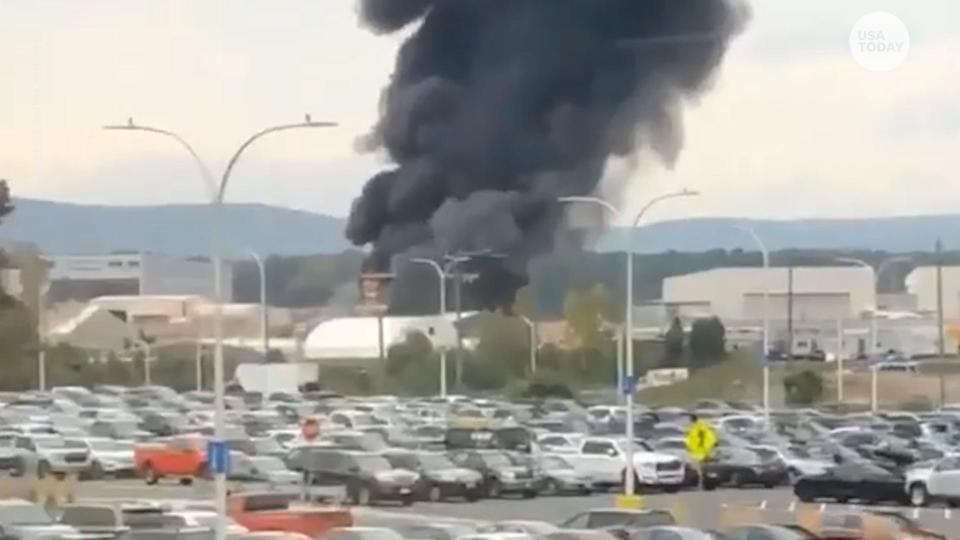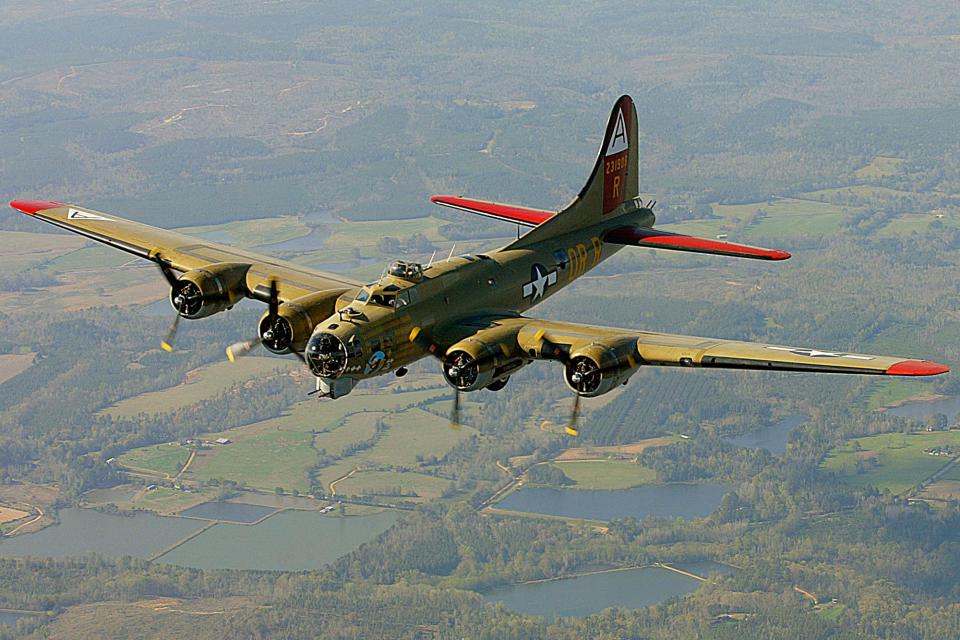Fiery B-17 plane crash has people asking: Are vintage bomber rides dangerous?
To those who love old planes, it's a breathtaking experience.
You climb aboard a vintage bomber, hear the rumble as its four propellers roar to life, then fly off into the wild blue yonder to experience first-hand the warplanes that played a key role in liberating Europe from the Nazis.
But after the Boeing B-17 bomber crash Wednesday that claimed seven lives and injured six, some are questioning whether the bombers are safe for paying passengers at all.
The plane involved in the crash, a B-17G Flying Fortress nicknamed the "Nine-O-Nine," was built in 1944. Though rugged and designed to withstand battle damage, old planes were built in an era before modern aircraft safety standards and were never intended to carry passengers — only bombs, guns and a military crew.

The Nine-O-Nine, which crashed near Hartford, Connecticut, was one of several vintage planes around the country that take paying passengers aboard for short flights. And the crews manning the planes can be as old as the aircraft themselves. The B-17G's pilot, Ernest McCauley of Long Beach, California, was age 75. Co-pilot Michael Foster of Jacksonville, Florida, was 71. Both are presumed dead.
Before Wednesday's crash, vintage World War II-era bombers are listed as having been involved in 21 accidents investigated by the National Transportation Safety Board since 1982, when its database began. Three were B-17Gs. All those crashes killed 23 and injured one before the latest accident is included.
To Jennifer Homendy, who is leading the NTSB crash-investigation team in Hartford, the toll was already too high — especially since her standard for a safe plane is zero incidents.
"I think 21 incidents is tragic and 23 deaths is completely unacceptable," she said in an interview.
So far, the cause of Wednesday's crash is undetermined, though the pilots reported engine trouble minutes after takeoff and requested a return to Bradley International Airport. The bomber crashed into a deicing facility, catching fire, after clipping a series of runway landing lights, Homendy said.
When a historic flight goes well: Passenger describes a different ride aboard the Nine-O-Nine
Though the NTSB is far from ready to issue recommendations such as barring passengers, the crash is spurring new calls to look at regulations.
"This tragic crash raises very significant and urgent issues about the safety requirements of these vintage aircraft," said Sen. Richard Blumenthal, a Connecticut Democrat. "Most of them are 70 years old, providing tourist and sightseeing attractions for people who trust they are boarding an airplane that is maintained and inspected in the same way that commercial aircraft are. The fact is, they may not be."
Consequently, Blumenthal said the planes appear to be operating in a "gray area," somewhere short of commercial airline standards, and likely in need of greater regulation.
Retired military planes aren't suitable for carrying passengers, said Mike Slack, an Austin-based lawyer who specializes in aviation issues.
Given their ages, they are "not only at greater risk to have equipment failures in the airplane ... but they are not built to any crash standard," Slack said. They, for instance, are likely to lack fuel-containment features that are standard in modern planes, such as bladders around tanks, automatic self-sealing and fracture-resistant fuel lines.

The FAA says former military aircraft can fly only what it calls "Living History" flights, an exemption to normal FAA rules that applies only to planes deemed historically significant. Flights are only allowed when "an applicant has demonstrated a public need, and demonstrates that an equivalent level of safety can be achieved."
One of the largest vintage collectors, the nonprofit Commemorative Air Force with 174 aircraft spread over about 60 locations, has a Living History flight experience. It provides "a strong connection" to the planes for the many who take rides, according to Leah Block, the vice president of marketing. "Safety is definitely number one," she said, with careful maintenance of aircraft and safety briefings for passengers.
But even then, incidents can happen. A C-47 transport operated by the CAF, the military version of the DC-3 twin-engine passenger plane built in1944, caught fire last year on takeoff from Burnet, Texas. All 13 aboard were able to escape even as the plane, dubbed the "Bluebonnet Belle," was destroyed.
The B-17G involved in Wednesday's crash had been involved in one previous incident in 1987, when it ran off a runway in Pennsylvania. The bomber, operated by the nonprofit Collings Foundation, was last inspected in January, the NTSB said. There are 16 B-17Gs currently registered in the U.S., including the one that just crashed. They are among the last remaining from thousands turned out during the war.
Those who catch a ride on one of the vintage planes say it's an unforgettable experience, risks aside.
Anthony Roman, a former corporate pilot who runs a commercial investigative and intelligence firm, said he rode aboard the Nine-O-Nine several years ago on a 45-minute flight from an airport in Farmingdale, New York. He said he paid about $450 for the experience.
"With its storied history, it was humbling," Roman said. "The first thing I felt was for the 17- to 22-year-old boys who fought, and many died fighting, in these aircraft for Europe's freedom and the world's freedom."
He said he talked to the pilots and crew, impressed at their professionalism, and came away with the impression the plane had been impeccably maintained. He signed a liability waiver. He and the other passengers were given a safety briefing before sitting facing each other in the rear of the fuselage. They had to be instructed on how to use the vintage seat belts.
Also reassuring, he said: He knew the plane was so ruggedly built for combat and had four engines and the ability to fly without one or more of them. He compared the experience of taking a trip aboard a B-17 to taking a spin in a 1963 Chevrolet Corvette, a classic sports car — a reasonable gamble compared with a modern car equipped with the latest safety technology.
"They carry somewhat more risk," Roman said of the B-17, "but they are not unsafe."
Contributing: The Associated Press
This article originally appeared on USA TODAY: B-17 plane crash at Bradley Airport: Are old bombers safe to fly?

